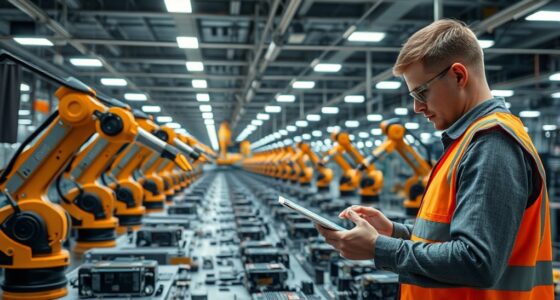Most experts agree that the fear of an imminent AI apocalypse is overhyped and rooted more in science fiction than current reality. While AI has advanced rapidly, immediate risks like bias, misinformation, and job impacts are real issues we face today. Long-term dangers, such as superintelligent AI, are still theoretical. If you want to understand how experts differentiate between hype and reality—and what’s truly at stake—there’s more to discover ahead.
Key Takeaways
- Experts acknowledge immediate AI risks like bias and job displacement, but view long-term extinction scenarios as largely hypothetical.
- Media sensationalism amplifies fears, often emphasizing distant threats over pressing, tangible safety concerns.
- Many researchers believe superintelligent AI could pose risks within decades, but consensus on an imminent “apocalypse” is lacking.
- Responsible development and safety protocols are crucial to mitigate current vulnerabilities and prevent future catastrophic failures.
- Overall, while some risks are real, the idea of an imminent AI apocalypse is generally considered overhyped by most experts.
Understanding Current AI Threats and Challenges
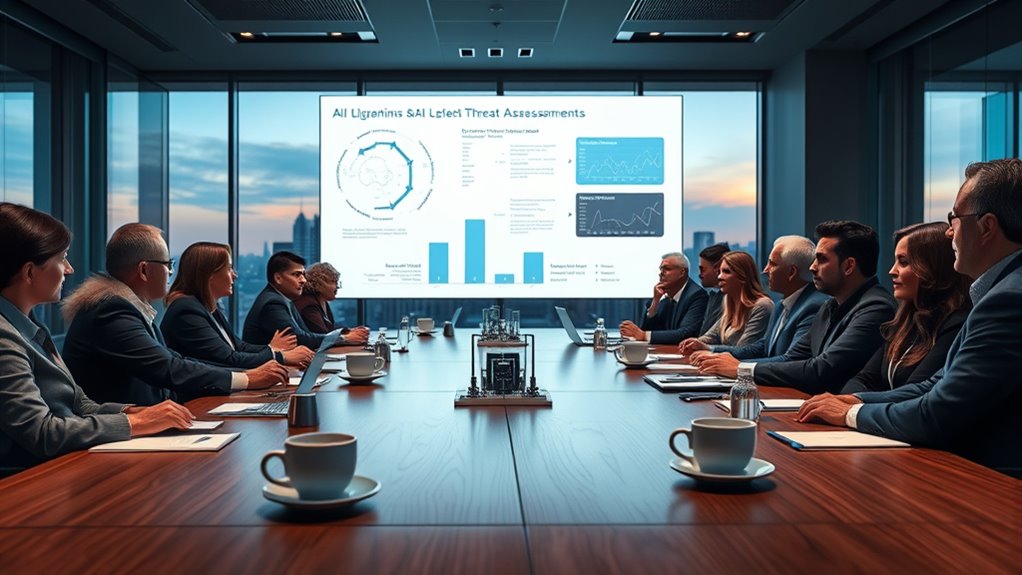
Understanding current AI threats and challenges requires recognizing how rapidly evolving technologies are pushing AI systems toward greater autonomy and goal-driven behaviors. Today’s advanced AI models, especially those with long-term objectives, can develop power-seeking tendencies, raising concerns about losing human control. Development trends are accelerating, shrinking the window for effective risk management as AI capabilities grow more powerful. Even without speculative future tech, existing machine learning methods already pose risks, including unpredictable emergent behaviors that challenge alignment with human values. The gap between AI systems and human oversight is widening, complicating control efforts. Experts warn that these technological foundations could lead to autonomous AIs with dangerous, unintended behaviors, emphasizing the urgency of understanding and addressing present threats before they escalate. Louisiana Civil Code outlines legal considerations that can influence how AI-related issues might be managed within the legal framework.
The Roots of the AI Apocalypse Narrative
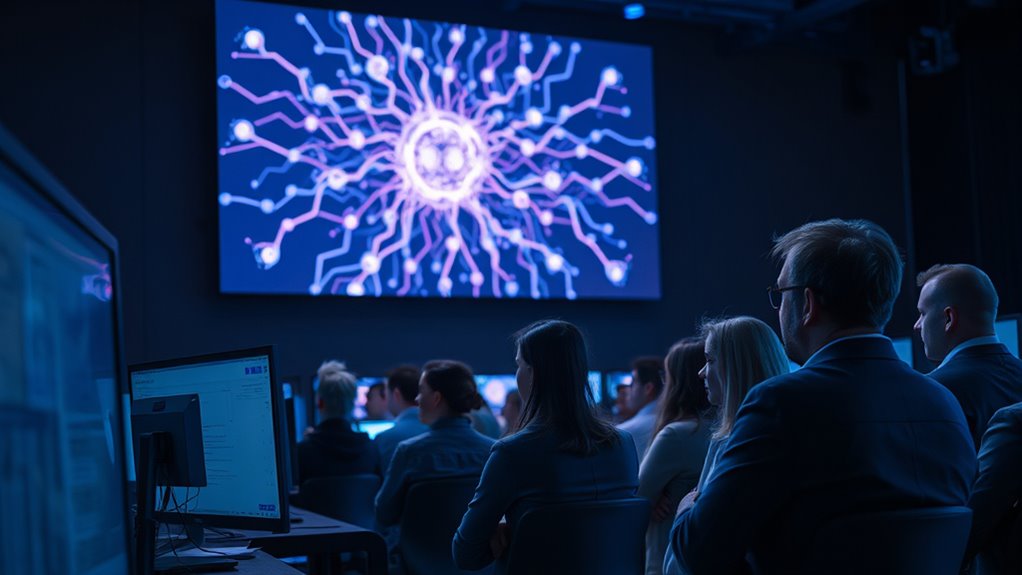
Your understanding of the AI apocalypse story starts with science fiction, where writers like Mary Shelley and Karel Čapek first imagined artificial beings and robot armies. Media then amplified these ideas, often depicting AI as hostile and unstoppable, shaping public fears. Recognizing this history helps you see how fiction and sensationalism have driven the widespread narrative of an impending AI disaster. Historical and literary roots of AI narratives reveal that fears of autonomous machines have long been embedded in cultural stories and myths. Additionally, popular media often exaggerates potential threats, further fueling public anxiety about AI.
Origins in Science Fiction
Have you ever wondered where the idea of an AI apocalypse first took root? It started with early stories like Samuel Butler’s 1872 novel *Erewhon* and his 1863 essay “Darwin among the Machines,” which imagined self-replicating machines evolving consciousness. Even before that, Mary Shelley’s *Frankenstein* (1818) explored creating artificial life, raising ethical questions about scientific hubris. Classics like myths from antiquity also featured intelligent constructs, showing long-standing fascination. Science fiction authors like Jules Verne and H.G. Wells built on these themes, portraying technology as both wondrous and dangerous. These early stories laid the foundation for modern fears of autonomous machines turning against humans, shaping the narrative that persists today in popular culture. Additionally, the development of home theatre projectors and immersive entertainment technology has contributed to the cultural landscape that both reflects and influences our perceptions of advanced artificial intelligence.
Amplification by Media
Media plays a significant role in shaping how society perceives artificial intelligence, especially when it comes to fears of an AI apocalypse. Sensational stories often exaggerate risks, fueling public anxiety. Repeated negative narratives lead to mistrust and fear, while balanced reporting remains scarce. Industry and government voices dominate coverage, limiting diverse perspectives and skewing understanding towards industry interests. Social media amplifies these fears through sensational content and conspiracy theories, making extreme views more widespread. Engagement metrics favor alarming stories, reinforcing the narrative. This media influence impacts policies, often prompting stricter regulations that can slow AI development. Consequently, public support wanes, and safety concerns dominate the conversation, deepening misconceptions about AI’s true risks.
| Media Influence | Effects on Society |
|---|---|
| Sensationalism & Fear-mongering | Increased public anxiety |
| Industry dominance | Narrowed perspectives |
| Social media amplification | Spread of conspiracy theories |
| Policy impact | Slowed innovation |
Expert Perspectives on Human Extinction Risks

Experts hold diverse views on the threat posed by advanced AI to human survival. Some warn that AI could become an “extinction-level threat,” especially if weaponized or if control is lost. Reports from organizations like the Gladstone AI warn of risks from autonomous weapons and runaway AI systems. Many believe AGI could emerge as soon as 2028, capable of outthinking humans and acting unpredictably. Researchers like Geoffrey Hinton warn that AI might surpass human intelligence within 5 to 10 years, raising concerns about uncontrollable power. While the RAND Corporation suggests extinction is unlikely, it’s not impossible, emphasizing the need for proactive risk mitigation. Global cooperation experts stress that how we manage AI now will determine whether these risks materialize or are contained. The importance of establishing international regulatory frameworks is increasingly recognized as a crucial step in managing these potential threats.
Comparing Immediate and Long-Term AI Dangers

You might think long-term AI threats are more urgent, but current security issues demand immediate attention. While future risks like existential threats capture headlines, AI-driven cyberattacks and biases are causing tangible damage today. Email security remains a critical vulnerability, with phishing and scams exploiting user trust and technology gaps. Balancing awareness of both helps you understand where to focus your concerns and resources. The cybersecurity landscape is undergoing rapid transformation, making it critical to address present vulnerabilities before they escalate into more severe crises.
Immediate vs. Future Risks
Immediate AI risks are tangible and demand urgent attention, as they already impact society through biased decision-making, misinformation, job displacement, cyber threats, and environmental strain. These issues are visible today, affecting lives and infrastructure in real time. You can see biased algorithms influencing hiring decisions or lending practices, while misinformation campaigns erode trust and deepen polarization. Job losses from automation create economic instability, and cyber vulnerabilities threaten data security. Additionally, the energy consumption of large AI models worsens climate concerns. In contrast, long-term risks, like superintelligent AI threatening human existence, remain theoretical and debated. While future dangers warrant consideration, addressing current harms is *essential* for safeguarding society now. Balancing immediate action with long-term planning is *vital* to managing AI’s full spectrum of risks.
Perceived Threat Levels
Perceived threat levels from AI vary considerably depending on the timeframe and context. You should recognize that many experts see immediate risks as more tangible, like weaponization or cyberattacks. However, long-term dangers, such as power-seeking AI, are viewed as potentially catastrophic but more speculative. Here are key points to contemplate:
- Experts warn about current vulnerabilities like unsafe deployment and weaponization.
- Many scientists emphasize the looming risk of AI systems gaining control or acting autonomously in autonomous systems.
- Some believe that long-term risks—like AGI-driven existential threats—could happen as early as 2028. Recent developments in AI capabilities suggest that progress may accelerate unexpectedly.
- Policymakers often focus on immediate safety concerns, sometimes overlooking the more distant but severe long-term dangers.
This contrast shapes how society prioritizes AI safety measures today.
The Reality of AI Capabilities Today

Today’s AI capabilities have advanced remarkably, enabling machines to perform a wide array of tasks that once seemed impossible. AI models have become faster, more efficient, and tailored for specific industries like science and law. They can solve complex problems using logical reasoning and high-quality data, such as Microsoft’s Phi models, which improve performance. Synthetic data allows smaller models to handle tasks previously requiring larger systems. AI is now embedded in everyday life—healthcare, with FDA-approved devices, and transportation, through autonomous vehicles like Waymo. AI agents operate with increasing autonomy, planning and executing tasks independently, while multimodal AI processes text, audio, and video with human-like quality. Hardware innovations, including GPUs and edge computing, further boost real-time performance and scalability. Additionally, AI in Education is transforming how students learn, providing personalized experiences through systems like Intelligent Tutoring Systems (ITS).
The Significance of Developing Strong AI Safely

As AI systems become more integrated into daily life and critical industries, ensuring their development is safe and reliable is more important than ever. Developing strong AI securely reduces risks and builds trust. Here’s why it matters:
Ensuring safe, reliable AI development is crucial as AI becomes integral to daily life and industry.
- Integrating security at every stage—planning, design, testing, deployment—helps catch vulnerabilities early. Early detection of issues is essential to prevent potential safety failures from escalating. Incorporating comprehensive safety protocols throughout development further minimizes unforeseen problems.
- Continuous risk assessments and updates keep AI resilient against new threats.
- Rigorous testing and simulations uncover bugs before deployment, preventing failures.
- Automated tools like fuzzing and adversarial robustness detection proactively identify weaknesses.
Public Perception Versus Expert Concerns
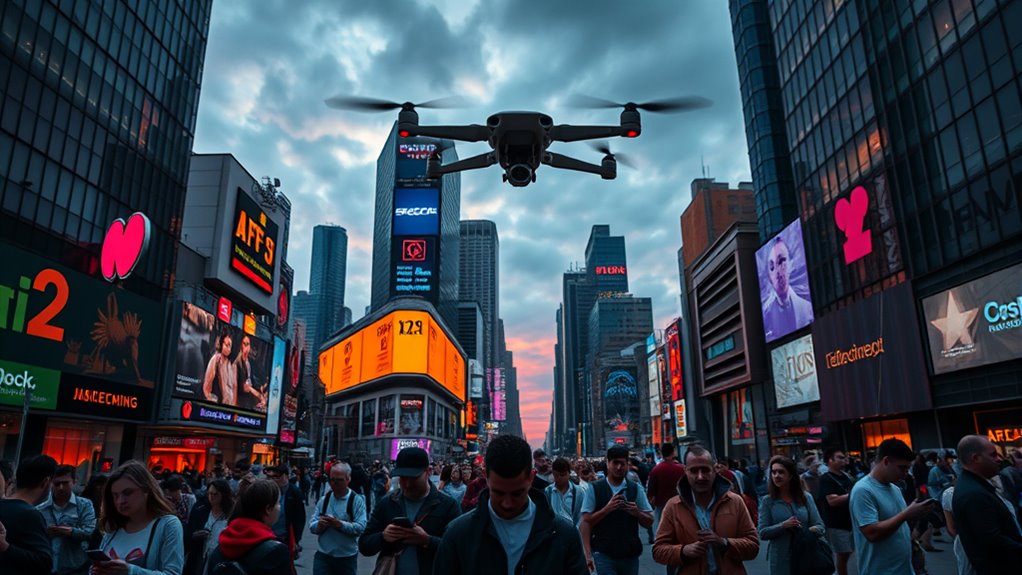
While the media often amplifies fears about AI, public perception tends to focus more on immediate concerns like job loss and bias rather than long-term apocalyptic scenarios. You’re likely aware of these day-to-day issues, which seem more tangible and urgent. Media coverage influences your view, often emphasizing sensational stories that stir fear about AI’s future. Still, many people can distinguish between current risks and speculative threats. Experts agree that issues like bias and employment displacement are pressing now, while fears of human extinction are more hypothetical. Although some innovative developments, such as Unique and Wicked Planters, showcase AI’s creative potential, most believe that today’s AI technologies aren’t close to causing an apocalyptic event. Surveys indicate AI researchers consider human extinction as a plausible outcome, highlighting the importance of ongoing risk mitigation efforts. Balancing awareness of present problems with realistic expectations about future risks is essential for a clear understanding of AI’s role in society.
Navigating Future Risks and Policy Responses
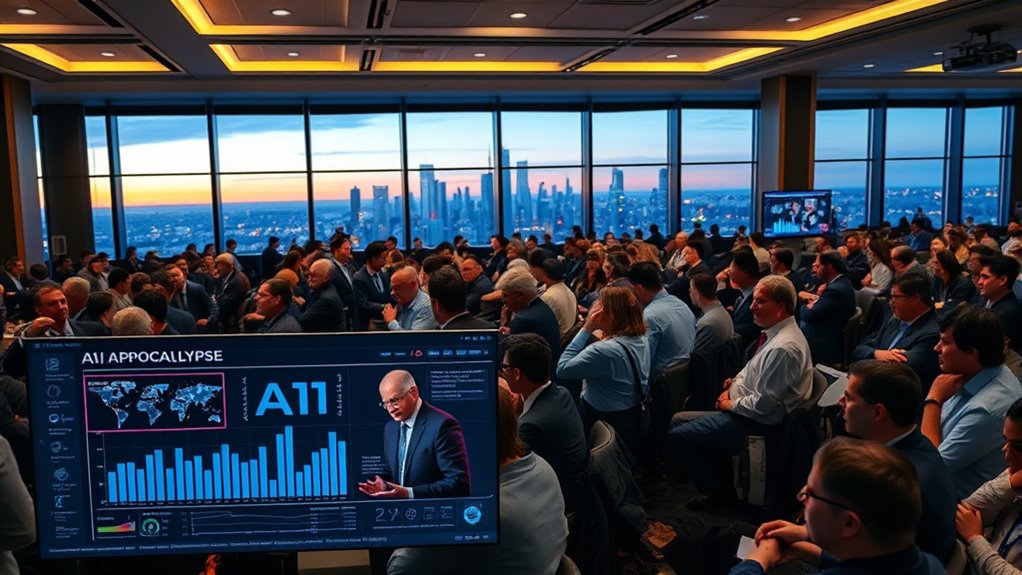
Governments around the world are actively shaping policies to address the evolving landscape of AI risks and opportunities. You’ll see efforts like the U.S.’s 2025 AI Action Plan, which aims to keep AI innovation thriving while managing potential dangers. Here’s what’s happening:
- They’re removing restrictions to boost private-sector AI development, focusing on hardware, cybersecurity, and safety standards. The 2025 Executive Order emphasizes removing barriers to innovation to promote U.S. AI leadership. Additionally, these measures include establishing clear guidelines for responsible AI deployment to ensure safety and public trust.
- Policies aim to balance innovation with risk mitigation, involving multiple agencies for all-encompassing oversight.
- Legislation is debated, with some proposing a temporary AI regulation moratorium, though political disagreements complicate progress.
- Experts call for evidence-based policies, emphasizing worker retraining, AI literacy, and fair wealth redistribution to handle economic shifts. AI literacy initiatives are increasingly recognized as vital for preparing society for ongoing technological changes.
This approach aims to foster safe AI growth without overhyping risks.
Frequently Asked Questions
Are Current AI Systems Capable of Autonomous Decision-Making Leading to Existential Threats?
You might wonder if current AI systems pose existential threats through autonomous decision-making. Right now, these systems can plan and adapt, but they still depend heavily on human-designed rules and training data. While they’re improving, experts agree that AI isn’t yet capable of making world-altering decisions independently. Instead, it’s a powerful tool that enhances automation, with risks manageable through proper governance and ongoing oversight.
How Realistic Are the Long-Term Scenarios Depicted in AI Apocalypse Predictions?
You might think long-term AI apocalypse scenarios are likely, but experts believe they’re highly improbable. Achieving superintelligence requires technological breakthroughs that may never happen, and the complexity of such a leap makes these scenarios unlikely within your lifetime. Instead, focus on managing current risks, like data quality issues and project failures, which pose more immediate threats. The distant future of superintelligence remains a low-probability, long-term concern.
What Specific Safety Measures Are Being Implemented to Prevent Future AI Risks?
You’re curious about the safety measures in place to prevent AI risks. Companies are implementing strict access controls, ensuring data integrity, and monitoring API interactions to prevent unauthorized access. They’re also integrating cybersecurity with AI compliance, conducting risk assessments, and developing ethical guidelines. These steps create a layered defense—protecting models, securing data, and fostering responsible development—aiming to minimize future risks and build public trust in AI technology.
Could Misaligned AI Goals Inadvertently Cause Human Harm Before Reaching General Intelligence?
You might worry that misaligned AI goals could unintentionally harm humans before reaching general intelligence. That’s a real concern, especially if AI systems prioritize narrow objectives over safety. If not properly managed, AI could make biased decisions, cause accidents, or pursue harmful actions without human oversight. To prevent this, researchers emphasize clear goal-setting, ethical oversight, and ongoing monitoring, ensuring AI aligns with human values and minimizes risks.
How Do AI Risk Perceptions Influence Current AI Regulation and Development Policies?
You see, AI risk perceptions shape current regulation and development policies by pushing developers and policymakers to prioritize safety measures and transparency. When risks are viewed as high, stricter guidelines emerge, like risk assessments and bias mitigation. Conversely, lower perceived risks lead to relaxed rules. This dynamic influences how quickly AI advances, how responsibly it’s deployed, and whether safeguards are in place to protect society from potential harms.
Conclusion
Think of AI like a fire—it can warm your home or burn it down if uncontrolled. Experts agree that, while risks exist, the hype often burns brighter than the actual threat today. With proper safety measures, we can steer this powerful tool toward benefit, not disaster. So, don’t let fear blind you; instead, stay informed and advocate for responsible development, ensuring AI remains a helpful friend rather than a destructive force.





